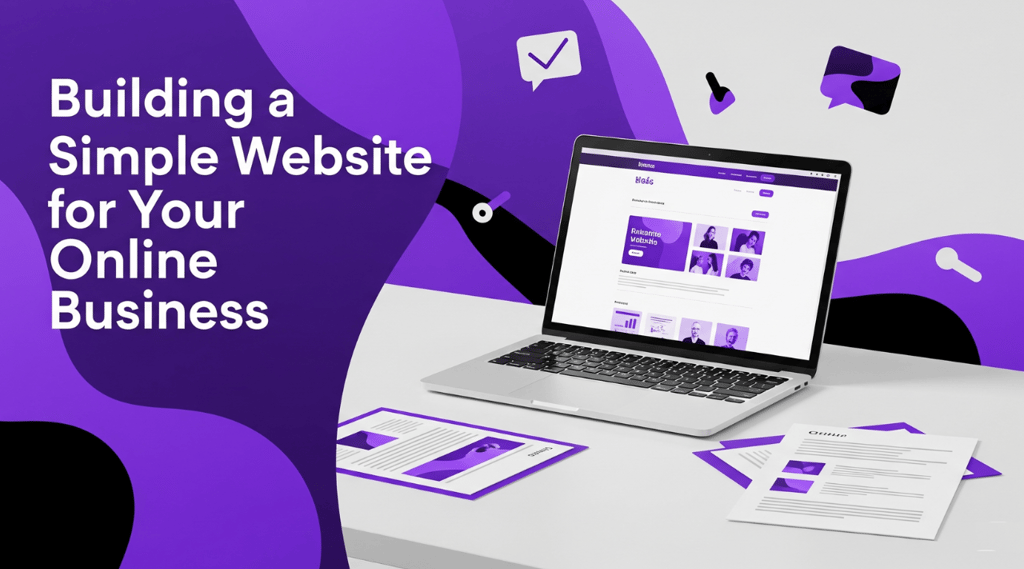A Step-by-Step Guide to Building a Simple Website for Your Online Business
Our guide to Building a Simple Website for Your Online Business covers everything from picking the right platform (WordPress, Shopify, Wix) to SEO, essential pages, and launch. Get your business online effectively!
Eddy Enoma
6/21/20257 min read
Building a successful online business starts with a strong online presence, and at its core is a well-designed and functional website. This step-by-step guide will walk you through the essential stages of creating a simple yet effective website for your online venture.
Understanding the Purpose of Your Website
Before embarking on the journey of building a website for your online business, it is imperative to define its purpose clearly. Understanding the primary goal of your website not only informs the design and development process but also shapes the content and marketing strategies you'll employ. Different types of websites serve various needs, and identifying yours will guide significant decisions throughout the project.
For example:
E-commerce store: Your site will require features that facilitate online transactions, such as secure payment gateways, product display, and inventory management.
Blog: Focused on sharing information and insights, it may prioritize a clean layout with easy navigation to enhance the reading experience.
Portfolio site: Designed to showcase your work, it will emphasize high-quality visuals and an easy Browse of your projects.
Understanding whether your website's objective is to sell products, showcase a portfolio, or simply share valuable information will influence every stage of your website's creation.
Additionally, identifying your target audience is crucial in defining your website's objectives. Knowing who you intend to reach allows you to tailor content and design elements that resonate with them, thereby increasing engagement and effectiveness. For instance, if your target demographic is primarily young professionals, your website's aesthetics and functionality should cater to their preferences, perhaps utilizing modern design trends and integrating social media sharing features.
Moreover, having a clear purpose helps in selecting the right platform for your website. Different platforms offer various templates, functionalities, and levels of sophistication. Choosing a platform that aligns with your defined goals can enhance user experience and facilitate smoother operation.
In summary, the foundation of a successful online business website lies in precisely understanding its purpose. By clarifying goals, understanding your target audience, and making informed choices about design and functionality, you set the stage for an effective online presence. This clarity will ultimately lead to a more coherent and purposeful website that meets the needs of your business and serves your audience effectively.
Choosing the Right Platform: WordPress, Shopify, or Wix?
When embarking on the journey to build a website for your online business, selecting the right platform is crucial. Three of the most popular website-building platforms are WordPress, Shopify, and Wix, each catering to different business needs and technical abilities.
WordPress:
Pros: Known for immense customization options with thousands of themes and plugins, allowing intricate designs and unique functionalities. It offers maximum control.
Cons: Steeper learning curve, especially for beginners. While the software is free, costs can accumulate through premium themes, plugins, and hosting.
Best for: Businesses wanting maximum control and customization.
Shopify:
Pros: Specializes in e-commerce, simplifying online store setup with built-in payment processing. User-friendly interface, ideal for those without extensive technical skills.
Cons: Can come at a higher price point, especially as businesses scale and require additional features.
Best for: Businesses focused exclusively on selling products online.
Wix:
Pros: Drag-and-drop functionality allows users to build visually appealing websites without coding knowledge. Quick and effective setup.
Cons: More extensive customization might be limited compared to WordPress. Additional costs can arise for advanced functionalities.
Best for: Small businesses, portfolios, or service providers seeking simplicity and quick setup.
By understanding these differences, you can make an informed decision about which platform best aligns with your business objectives and technical skill level.
Domain Name Registration and Hosting
Choosing the right domain name is pivotal in establishing a successful online presence for your business. A good domain name not only reflects your brand identity but also conveys professionalism and credibility to potential customers.
Domain Name Best Practices:
Brainstorm keywords or phrases that summarize your business's niche.
Ensure the name is memorable, easy to spell, and not overly lengthy.
Check availability through domain registration services (e.g., GoDaddy, Namecheap).
Opt for a ".com" extension generally, though ".net" or ".co" can be suitable alternatives.
After securing your chosen domain name, the next step is to consider web hosting. Reliable hosting services are crucial for ensuring that your website is accessible to users at all times.
When evaluating hosting options, pay attention to:
Server speed: A slow website deters potential customers.
Uptime guarantees: Consistent uptime is vital for accessibility and search engine rankings.
Customer support: Essential for troubleshooting and assistance.
Scalability: Choose a provider that allows for easy upgrades as your business grows.
Added features: Look for free SSL certificates and website backups for security and reliability.
For an excellent and reliable hosting solution, we recommend checking out Hostinger. By thoughtfully selecting a domain name and reliable hosting service, you'll lay a strong foundation for your online business.
Designing Your Website: Selecting a Template and Customization
When building a simple website, the initial step involves selecting a suitable template or theme provided by your chosen platform. This choice is critical as it establishes the foundation for your site's overall aesthetic and user experience. It's essential to choose one that resonates with your brand identity and effectively communicates your business's message.
Once you've selected a template, the next phase is customization. The goal is to align the template with your brand's identity by adjusting key elements:
Layout: A well-organized structure enhances navigation and ensures users can find information effortlessly. Opt for a layout that complements your content and facilitates a natural flow of information.
Responsive Design: Prioritize responsive design to ensure your website performs seamlessly across various devices, from desktop computers to smartphones.
Color Schemes: Significantly impact a visitor’s perception of your brand. Choose colors that reflect your brand's personality while maintaining readability. Tools like Adobe Color can help create harmonious palettes.
Typography: Plays a crucial role; select fonts that are not only aesthetically pleasing but also easy to read. Consistency in font choices promotes a professional appearance.
Navigation: Key to improving user experience. Ensure menus are clear and intuitive, allowing visitors to move through your website effortlessly. Consider including a search bar for enhanced usability.
For generating innovative ideas for your website content and design, consider exploring AI-powered tools like Predis AI and 10Web AI. These can assist in sparking creativity and streamlining your design process. By investing time in selecting and customizing a template that aligns with your brand’s identity, you'll build a website that is visually appealing, functional, and capable of driving user engagement.
Adding Essential Pages and Content
When building a website for your online business, it is crucial to include essential pages that not only enhance user experience but also facilitate better engagement with your audience. The core pages every website should have include:
Home Page:
Acts as the introductory point, providing a concise overview of what your business offers.
Should highlight key services/products, feature appealing images, and clear calls-to-action.
Utilize compelling copy to make a strong first impression.
About Page:
Offers insight into your business's story, values, and mission, allowing potential customers to form a personal connection.
Incorporate relatable anecdotes or testimonials to build authenticity and trust.
Services/Products Page:
Outline what you offer in detail, explaining each service or product clearly and its benefits.
A perfect place to naturally integrate keywords relevant to your industry for improved search engine optimization (SEO).
Blog (Optional but Recommended):
If your goal is to share information, insights, or build thought leadership, a blog is essential. It also helps with SEO by providing fresh, relevant content.
Contact Page:
Provide multiple ways for potential clients to reach out (form, email, phone number).
Include essential legal considerations such as privacy policies and terms of service to ensure transparency and safeguard your business and visitors.
For streamlining content creation and organization, Content Studio can be a valuable asset. If you're looking to enhance your content with engaging video, consider using Invideo or Pictory for automated video creation.
Optimizing Your Website for Search Engines
Search Engine Optimization (SEO) is a crucial element for enhancing the online visibility of your website. Proper SEO practices can significantly enhance your online presence, allowing potential customers to easily find your services.
Key SEO Strategies:
Keyword Research:
Identify terms and phrases potential customers use.
Tools like Google Keyword Planner are a good start. For more in-depth analysis of competition and search volume, consider a dedicated SEO suite like Mangools.
Naturally incorporate these keywords into your content.
On-Page Optimization:
Refine elements on your website to improve ranking.
Optimize content with relevant keywords.
Ensure the website is mobile-friendly and has a fast loading speed.
Improve user experience and utilize headers (H1, H2, H3, etc.) to structure content effectively.
Tools like Surfer SEO can help you optimize content based on top-ranking articles.
For automated SEO optimization and management, explore Ranked AI.
Meta Tags:
Title Tags: Concise, include primary keyword, inform search engines and users about page content.
Meta Descriptions: Summary enticing users to click (doesn't directly affect ranking, but improves click-through rate).
Utilize SEO plugins (e.g., Yoast SEO) to aid in optimization.
Analytics:
Track performance using tools like Google Analytics.
Gain insights into user behavior, traffic sources, and conversion rates to make data-driven decisions.
For generating compelling ad creatives to drive traffic, explore Adcreative AI. If you're looking to create interactive chat experiences for your website visitors, check out Chatbase.co.
Testing and Launching Your Website
Once your website is created, thorough testing before going live is critical to ensure a seamless user experience.
Key Testing Aspects:
Functionality: Verify all links work, forms are submitable, and interactive elements behave as expected.
Loading Speed: Utilize tools like Google PageSpeed Insights to analyze loading times and implement optimizations (e.g., compressing images, minimizing code). Slower loading websites lead to higher bounce rates.
Responsiveness: Test across various devices and screen sizes to confirm design and content display correctly on desktops, tablets, and smartphones.
User Experience (UX): Navigate through your site as a visitor would, ensuring an intuitive and positive experience. For creating helpful how-to guides and training materials to assist your users, consider Guidde.
Once testing is complete, it’s time to strategize for your website launch.
Launch Strategy:
Pre-launch Marketing: Generate interest and anticipation. Consider countdown timers or teasing content on social media.
Social Media Announcement: Craft engaging posts highlighting your site's unique value and encouraging shares.
Email Marketing: Announce your launch to your existing contacts. For managing your email campaigns and reaching your audience, powerful platforms like GetResponse or EmailOctopus are excellent choices.
Lead Capture: To effectively capture leads from your new site, explore tools like Magnetify.
Ongoing Maintenance:
Regularly update content, plugins, and security measures.
Monitor user analytics for insights into audience behavior, allowing for timely adjustments and enhancements.
For efficient project management and team collaboration throughout the website building and ongoing maintenance process, Taskade AI can be incredibly helpful. If you're exploring innovative AI tools for your content and online presence, also look into Pickaxe and Loveable.dev. For general support in optimizing your online business operations, consider Base44. And if you ever need to generate high-quality audio content, Elevenlabs offers advanced text-to-speech capabilities.
By prioritizing testing, strategic launch, and regular maintenance, you'll set a strong foundation for your online business's future endeavors.
For detailed information on many of the powerful tools mentioned in this article, please visit our comprehensive resources page.
Stay ahead in the online business world! Sign up for our newsletter below to receive exclusive tips, insights, and updates directly in your inbox.
Subscribe for Exclusive Tips & Updates. Enter Your Email Below!



Get the latest strategies on content creation, freelancing, and affiliate marketing, plus passive income straight to your inbox!
🔒 We respect your privacy. Your email is safe with us. Unsubscribe anytime.
Address
Sporerweg 16
94234 Viechtach, Germany
Contacts Us
(049) 170 499 6273
Subscribe to our newsletter
© 2026 Onlinebizoffers. All rights reserved.


